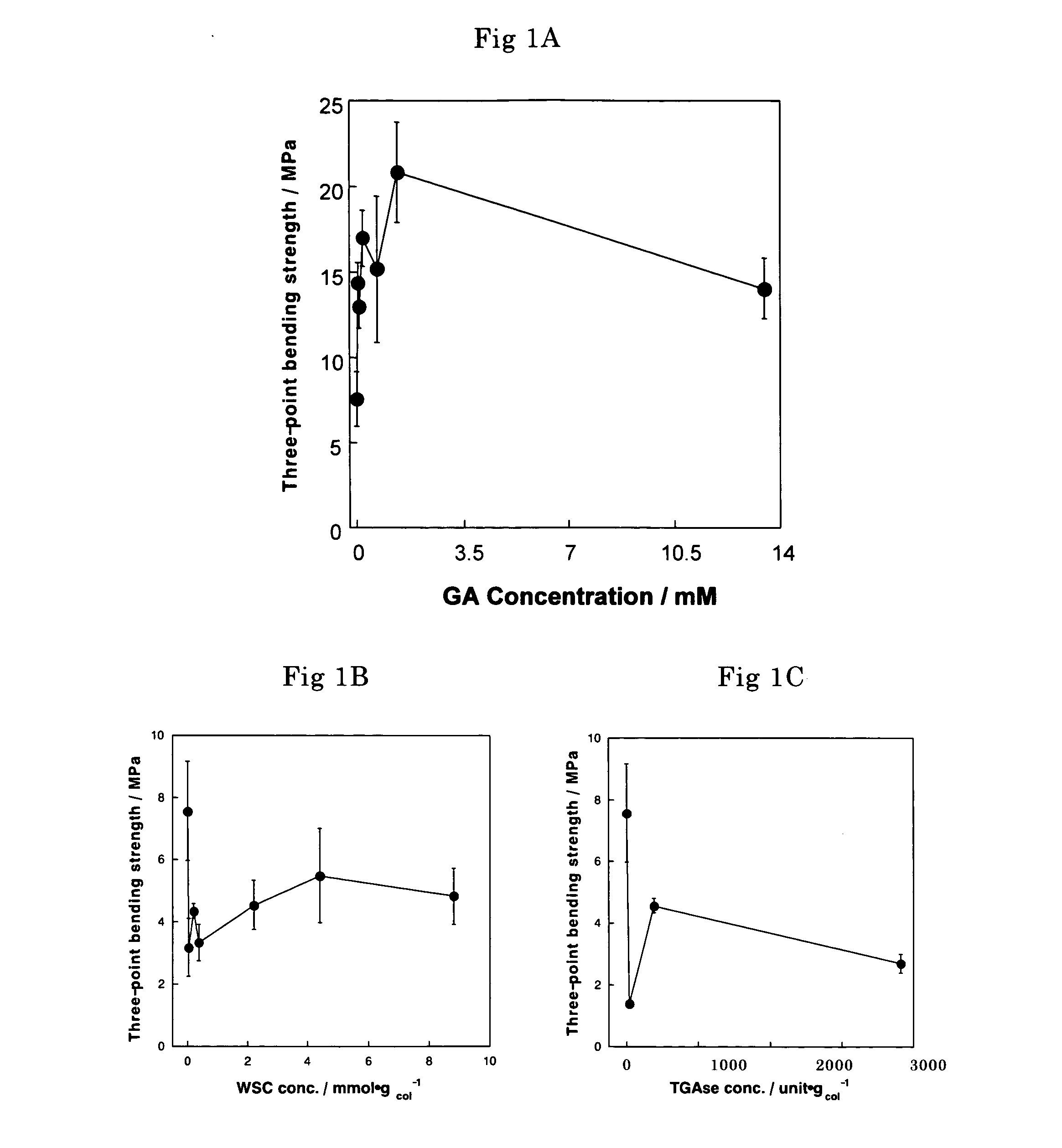Regulation of biodegradability of composite biomaterials
a biodegradability and biomaterial technology, applied in the direction of prosthesis, peptide/protein ingredients, drug compositions, etc., can solve the problems of imposing a heavy burden on patients, limited supply sources, and simple combination of hap and collagen cannot provide structures or properties similar to those of natural bones, so as to maintain mechanical strength
- Summary
- Abstract
- Description
- Claims
- Application Information
AI Technical Summary
Benefits of technology
Problems solved by technology
Method used
Image
Examples
example 1
Preparation of Crosslinked HAp / Col Composites
(1) Preparation of HAp / Col Composites
HAp / Col composites were prepared in accordance with the method of Kikuchi et al. (M. Kikuchi et al., Biomater., 22 (13), 2001, 1705-1711). At the outset, calcium carbonate (for alkali analysis, Wako Pure Chemical Industries, Ltd.), phosphoric acid (special grade, Wako Pure Chemical Industries, Ltd.), and porcine dermis-derived atelocollagen (Nitta Gelatin Inc.) were prepared as starting materials. Calcium carbonate was burned at 1050° C. and then digested through hydrolysis to prepare single-phase calcium hydroxide. An aqueous solution of phosphoric acid (24 mM, 2 dm3) containing a calcium hydroxide suspension (40 mM, 2 dm3) and collagen (2 g) was introduced into a reaction vessel via a tube pump. The pH level in the reaction vessel was adjusted to 9 using a pH controller, and the temperature was maintained at 40° C. using a warm water bath.
(2) Crosslinking
The reaction solution stand for 3 hou...
example 2
Test for Biodegradability of Crosslinked HAp / Col Composites Using Rabbit
(1) Testing Method
The biodegradability of the crosslinked HAp / Col composites was inspected by implanting the glutaraldehyde-crosslinked composites with various glutaraldehyde contents obtained in Example 1 (2×2×2 mm) in a rabbit tibia. These crosslinked composites were evaluated by visual inspection (FIG. 3) and by histological examination (hematoxylin-eosin staining) 1, 2, and 4 weeks after implantation.
(2) Results
The results of histological examination demonstrated that no toxic reaction, such as inflammatory reaction, was caused by the glutaraldehyde-crosslinked composites. Bone formation and bone conductivity equivalent to those in the case of non-crosslinked composites were observed in the vicinities of all the crosslinked composites.
The absorption / degradation rate of the crosslinked HAp / Col composites was reduced as the glutaraldehyde content increased. In the case of the composite with high-deg...
example 3
Bone Formation by Implanting Hydroxyapatite / Collagen(HAp / Col) Composite in Rat Model of Osteoporosis
1. Testing Method
(1) Preparation of Rat Models of Osteoporosis
5-week-old female SD rats (n=13) were prepared, and they were subjected to ovariectomy (OVX) or sham-operation (Sham) at the age of 6 weeks. All rats were fed with low calcium (Ca) diets (Ca: 0.01%, P: 0.2%; CLEA Japan, Inc.) and distilled water up to the age of 10 weeks to lower bone mineral content. Thus, rat models of osteoporosis were prepared.
(2) Preparation of HAp / Col Composite and Implantation Thereof in Rat Tibia
HAp / Col composites having structures similar to those of natural bones were produced in accordance with the method of Kikuchi et al. (Kikuchi, S. et al., J. Biomater., 22 (13), 2001, 1705-1711; S. Itoh et al., J. Biomed Mater Res., 2001, 445-453). The prepared composites were implanted in 10-week-old rat models of osteoporosis. Holes (diameter: 2 mm) were provided in the external cortical bones of...
PUM
| Property | Measurement | Unit |
|---|---|---|
| Fraction | aaaaa | aaaaa |
| Substance count | aaaaa | aaaaa |
| Substance count | aaaaa | aaaaa |
Abstract
Description
Claims
Application Information
 Login to View More
Login to View More - R&D
- Intellectual Property
- Life Sciences
- Materials
- Tech Scout
- Unparalleled Data Quality
- Higher Quality Content
- 60% Fewer Hallucinations
Browse by: Latest US Patents, China's latest patents, Technical Efficacy Thesaurus, Application Domain, Technology Topic, Popular Technical Reports.
© 2025 PatSnap. All rights reserved.Legal|Privacy policy|Modern Slavery Act Transparency Statement|Sitemap|About US| Contact US: help@patsnap.com



